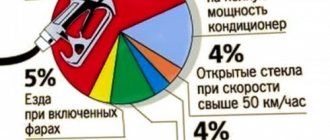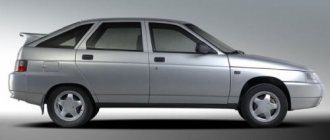VAZ
admin 04/18/2017 1 Comment
- Oka 0.7 Fuel consumption rate Oka 0.7 l per 100 km
- Real reviews about Oka fuel consumption 0.8 l per 100 km
- Real fuel consumption Oka 1.0 l
The small car "Oka", developed in 1988 at VAZ, was supposed to become one of the most popular cars before the collapse of the USSR, but until 1994 it was produced in small batches, and since 1995, production was completely transferred to KamAZ and SeAZ. The peak of production began in 1998, when Oka began not only to be sold domestically, but also actively exported - due to the fall in the ruble exchange rate, its price in foreign currency turned out to be ridiculous. But the outdated design of the body and power unit did not allow the car to successfully compete with higher quality and reliable foreign analogues in the early 2000s, so its production was discontinued in 2008.
Oka 0.7
From the very beginning, a VAZ-1111 micro-displacement carburetor engine with a volume of 649 cm3 was developed for the Oka. This two-cylinder engine was capable of developing a power of 30 hp. and reach a torque of 45 Nm. The engine was paired with a 4-speed manual transmission.
Oka fuel consumption rate is 0.7 l per 100 km
- Maxim, Ufa. I have an Oka VAZ-1111, manufactured in 1994. Despite its unpresentable appearance, the car is not bad and suits me 100%. For its weight, the engine power is quite enough. By the way, consumption in the city is quite normal - 5-7 liters, but on the highway, if you drive too hard, sometimes it can reach 10 liters.
- Timur, Ryazan. I took it literally for a couple of years - it was stupid to learn how to drive. Even if I knock or break it, I don’t mind at all. However, everything turned out to be not as sad as I thought. It drives and that’s the main thing, although it doesn’t even smell like comfort. The average consumption is 6 liters – which is a lot for the tiny volume under the hood.
- Georgy, Tambov. Oka is my first car. I got it from my dad, and before that it had been sitting in the garage for five years and was rusting. Of the advantages, I will only note its unpretentiousness and the fact that it is the same Lada, only neutered and trimmed down. Gasoline consumption with a normally adjusted carburetor is 6 liters in the city, more on the highway, because the gearbox is 4-speed and at more than 90 km/h it eats gasoline like a cow.
- Irina, Rostov. When I decided to learn to drive a car, I went to a driving school, after which my father finally entrusted me with his car - a 1992 Oka. At that time, for me it was just something - but now I understand that the car was an outright log and not worth a good word. It broke down constantly, the consumption in the city was no less than 6 liters, I now have this consumption on my Hyundai with an engine 2.5 times more and 3 times more powerful.
- Sergey, Moscow. At one time, I rode a 1993 Oka for about a year and a half. This was in 2008 - I needed wheels, but there was no money, so I took an Oka, which at that time cost me about $300 - just ridiculous money. I’ll tell you that in fact everything is not as bad as it seems - if we put aside emotions, demands for comfort and all that, then this car fulfills its main purpose of transporting you from point A to point B 100%, and nothing more. need to. Consumption in the city is on average 6.5 liters, and it is generally undemanding when it comes to the quality of gasoline.
Other cars: VAZ 2106 fuel consumption reviews
Oka carburetor design
Cars under the Oka brand were produced from 1987 until 2008, at first the VAZ-1111 was modified (with a 0.65-liter two-cylinder engine). The updated VAZ-11113 model was launched into production in 1995, and it received a 749 cm³ engine. Initially, for 0.65-liter engines, the Dimitrovgrad Automobile Unit Plant developed the DAAZ carburetor series 1111, which combined elements of the Ozone and Solex type HRVs. Later, the DAAZ-11113 model began to be produced for the 0.75-liter internal combustion engine (ICE), which later underwent a slight modernization.
Carburetor 11113 is a device for creating an air-fuel mixture in a certain proportion, which sets the stable operation of a car engine in all modes. The body of this unit consists of 3 parts: the top cover, the middle (main) part where the float chamber is located, and the bottom part with throttles (flaps), the carburetor device itself is a 2-chamber one, with sequential opening of the throttles.
The carburetor assembly includes:
- the main dosing system (abbreviated as GDS), operating in all modes, which includes diffusers, fuel/air supply jets for both chambers;
- idle speed system (abbreviated as XX), which allows the engine to operate stably at minimum speed and consume fuel economically;
- economizer, which enriches the fuel mixture at high speeds and heavy loads;
- accelerator pump, its main function is to ensure uniform operation without failures with any, even the most sharp, pressing of the accelerator (gas) pedal;
- a starting device that allows you to smoothly start a cold engine at low air temperatures;
- float chamber, due to which a constant level of gasoline in the carburetor is maintained, required for stable operation of the internal combustion engine.
- a transition system that makes it possible to achieve a smooth increase in speed, without jerking, during the opening of the secondary chamber.
Each of the systems in this unit performs its own specific task, and configuration and adjustment are carried out using adjusting screws, selection of jets, setting the angles of the throttle and air damper.
Oka 0.8
In 1995, on the basis of the fairly successful VAZ-21083 engine, a stripped-down two-cylinder version of the VAZ-1113 was developed, which was equipped with the Oka car. This 750 cm3 carburetor engine developed a power of 35 hp, and the engine torque was 52 Nm. The engine was paired with a 4-speed manual transmission.
Real reviews about Oka fuel consumption 0.8 l per 100 km
- Andrey, Vladimir. I have a 2002 Oka with a 0.75 liter engine. For the money, the car is not bad, but when compared with others, it loses to everyone. There are simply zero amenities in the cabin, it constantly breaks down, although spare parts are very cheap and cost pennies. Over the course of a couple of years, I replaced four bumpers – repairing them is not an option at all, only replacing them. Consumption in the city is 7.5 liters - I’m surprised, I thought it would be much less.
- Evgeniy, Kursk. The car was made in 1997, naturally I took it second-hand, with a mileage of more than 60 thousand km. At the same time, the car stood in the garage for almost 6 years - naturally, I had to change all the gaskets, rubber bands, etc., and fill in technical fluids. The problem was with the wiring - it kept melting. Nevertheless, it is quite unpretentious and easy to maintain, but the consumption is high, as for a 0.75 liter engine - approximately 7-7.5 liters in the city, 6.5 liters on the highway.
- Kirill, Ufa. Considering that the engine in my Oka is half of the figure-eight engine that is installed on the VAZ-21083, I can’t understand why it consumes so much gasoline. The actual consumption is within 7 liters, my friend has a VAZ-21083, so that one consumes 8-9 maximum.
- Dmitry, St. Petersburg. The main advantage of Oka is its compact dimensions. It looks like there's no room, but there's actually plenty of space, especially for the driver and front passenger. Of course not at the back, but that's not a problem. Plus you can park wherever you want - for St. Petersburg this issue is acute. Consumption in the city is about 7-8 liters, but it pulls surprisingly well, you can even overtake.
- Vladimir, Orel. I owned the VAZ-1113 Oka for almost 4 years. At the time of purchase, the mileage was 45,000 km, the car was owned by a retired grandfather, who drove it once every five years. The advantage of the car is its size and the 0.75 liter engine, which is high-torque for its volume. Everything else needs to be improved - the steering, suspension and so on have been redone. Well, the weak metal of the body began to rot very quickly, even though I cooked it.
Other cars: VAZ 2112 fuel consumption reviews
Oka 1111 and 11113 fuel consumption per 100 km
Oka is a car produced at the Russian factories VAZ, SeAZ and KamAZ. The history of its development begins back in the 1970s at the Serpukhov Automobile Plant, and the production of the Oka itself started only in 1988. Over a twenty-year production period, a total of about 700 thousand cars were produced.
Fuel consumption rate per 100 km
From the very beginning, the car was produced with a 0.7 liter engine with a power of 30 horsepower. The maximum speed that the 30-horsepower engine could reach was 120 km/h, and its fuel consumption was 6.5 liters in the city cycle and 5.5 liters on the highway.
- Sergey, Rostov. Lada (VAZ) 1111 (Oka) 0.7 MT 2005. This was my first car, now I drive the thirteenth model. The car is not bad in that it is easy to repair and has economical consumption. On average, about 6 liters are consumed per 100 km. The whole time I only cleaned the carburetor and that’s it. The car is very suitable for beginners.
- Maxim, Moscow. The car is so-so, since the Oka is designed to carry only one person, that is, just to take yourself for a ride. The quality of spare parts is at the lowest level. I had to completely go through everything in my 1993 VAZ. The only good thing is the consumption - in the city no more than 7 liters, on the highway 5.5-6 liters.
- Taras, Ufa. I took the car from my hands. Immediately after purchasing the 2000 Oka, I changed the brake pads and fuel filter. Overall, it’s a good car, especially well suited for driving around the city; there are no problems with parking. Due to the low weight on the track, the car is thrown in all directions. Fuel consumption is 6-6.5 liters.
- Georgy, Ryazan. I've been driving the 1994 Lada Oka for a long time, and I'm still happy with everything about it. Works 100 percent. The most important thing is to look after the car and change consumables. The 0.7 MT engine is peppy, especially at startup. Consumption is also excellent - only 6.5 liters in the city and 5.5 liters on the highway.
- Irina, Tambov. Lada 1111 0.7 MT 2007. The car is quite good and maneuverable. Just right for learning how to drive and what is under the hood. Consumption on average is 6 liters. The downside is that after a year and a half the car starts to fall apart no matter how you look after it. Very often the pipes from the stove break, plus every 6 months you have to weld the thresholds.
In 1995, the 0.7-liter was replaced by a new 2-cylinder engine with a volume of 0.8 liters. The power of such a unit is 33 horsepower, and the maximum speed is 130 km/h. At the same time, fuel consumption in the urban cycle is 7.4 liters, on the highway - 5 liters 11113
Real fuel consumption
- Vladimir, Peter. Lada (VAZ) 11113 (Oka) 0.8 MT 2000. The car, of course, lacks comfort, but its traction qualities are very normal. The engine runs well. Doesn't consume much oil or fuel. Per 100 km it comes out to around 6-6.5 liters. The big disadvantage of the Lada is its weak body, which does not resist corrosion well.
- Andrey, Orel. I see only advantages in my 2004 Oka. A very compact car - you can drive anywhere. The 0.8 MT engine consumes little fuel: about 7 liters in the city, 5 liters on the highway at 70 km/h. Despite such low consumption, the engine maintains good dynamics and can pull two people without any problems.
- Evgeny, Vladimir. I bought an Oka in 2007 with low mileage. The car is not bad, but now I have changed to another one. After modifying the suspension, the handling was excellent. I drove it for 4 years, after which the body began to crumble and became rather weak. The great advantage of this car is the 0.8 MT engine, it accelerates well and maintains a speed of 120 km/h on the highway. Consumption 7-7.5 liters.
- Kirill, Kursk. Lada (VAZ) 11113 (Oka) 0.8 MT 2002. Despite the many shortcomings of the car, it is still not bad. The salon, of course, without any amenities. It breaks down all the time, but repairs cost mere pennies. Bumpers burst very often. Fuel consumption is low - about 7.5 liters in the city, 5 liters on the highway.
- Dmitry, Ulyanovsk. I took the car second-hand (1997 model). It sat in the garage for a very long time. I changed all the rubber parts because they had dried out. I also had to change the wiring - it melted a lot. Now I’m driving, in principle, everything is fine so far. Gasoline consumption in the city is 7.3-7.5 liters, on the highway at 100 km/h 5.5 liters.
Information from the manufacturer
Along with 0.7 and 0.8 liter engines, the car was produced with a 1.0 liter engine. At the same time, the power of the power unit is significantly greater than the previous two - 53 hp. The maximum speed is 150 km/h, and fuel consumption in the city is 6.2 liters, on the highway - 4.5 liters.
Oka 1.0
The latest versions of the Oka, produced at SeAZ since 2006, received a Chinese three-cylinder small engine with a volume of 1000 cm3, which was also installed on the Daihatsu Charade G10. This engine was significantly superior in its characteristics to VAZ units - its power reached 53 hp and torque - 77 Nm. In addition, a more modern 5-speed manual transmission was offered for this engine.
Real fuel consumption Oka 1.0 l
- Yuri, Kaluga. I bought Oka for one simple reason - money, or rather, the lack of it. Actually, I have a GAZ-3110, but this car is too power hungry and not suitable for every day. But the Oka, especially with an imported engine, has low consumption, about 6.5 liters in the city and 5 liters on the highway - the Volga has two to two and a half times more. That’s why I ride the Oka all over the city, and if I go somewhere with my family, it’s on the Volga.
- Alexander, Kirov. I've had Oka for over 10 years. I have driven more than 200 thousand km. During this time, I made a capital overhaul of the engine - at 150 thousand km it stupidly caught a wedge, I had to completely overhaul it. By the way, after the capitalization the engine began to work perfectly simply - consumption dropped to 6 liters on average, sometimes even less, it pulls amazingly with such a volume. Plus I did the steering properly and slightly modified the suspension.
- Vasily, Samara. My Oka is a car for every day. I don’t care that the car is not prestigious - the main thing is that it drives and at the same time consumes a minimum of gasoline. I pump out 20-30 liters per day, covering 350-400 km. And it’s very cheap and easy to repair; it can be done by any auto mechanic whose hands grow where they need to.
- Dmitry, Simferopol. Through a friend, purely by chance, I became the owner of an Oka with a Chinese 1.0 liter engine. I bought it solely because of the price - they offered it to me for 400 bucks, a “penny” costs an order of magnitude more. The car is nothing at all - the interior completely sucks, there is no space at all, the engine has a thousand cubic meters, but in the city it consumes at least 7 liters of gasoline.
- Alexey, Moscow. My father-in-law gave me the car so I could learn to drive. He bought himself a Priora, and I didn’t have much money, so for me any option was normal. Over the course of 2 years, I certainly killed her in the trash, but I didn’t feel sorry for her. What was pleasing was the consumption of 6 liters, and sometimes even less.
Other cars: Lada Priora fuel consumption
Oka carburetor design
Cars under the Oka brand were produced from 1987 until 2008, at first the VAZ-1111 was modified (with a 0.65-liter two-cylinder engine). The updated VAZ-11113 model was launched into production in 1995, and it received a 749 cm³ engine. Initially, for 0.65-liter engines, the Dimitrovgrad Automobile Unit Plant developed the DAAZ carburetor series 1111, which combined elements of the Ozone and Solex type HRVs. Later, the DAAZ-11113 model began to be produced for the 0.75-liter internal combustion engine (ICE), which later underwent a slight modernization.
Carburetor 11113 is a device for creating an air-fuel mixture in a certain proportion, which sets the stable operation of a car engine in all modes. The body of this unit consists of 3 parts: the top cover, the middle (main) part where the float chamber is located, and the bottom part with throttles (flaps), the carburetor device itself is a 2-chamber one, with sequential opening of the throttles.
The carburetor assembly includes:
- the main dosing system (abbreviated as GDS), operating in all modes, which includes diffusers, fuel/air supply jets for both chambers;
- idle speed system (abbreviated as XX), which allows the engine to operate stably at minimum speed and consume fuel economically;
- economizer, which enriches the fuel mixture at high speeds and heavy loads;
- accelerator pump, its main function is to ensure uniform operation without failures with any, even the most sharp, pressing of the accelerator (gas) pedal;
- a starting device that allows you to smoothly start a cold engine at low air temperatures;
- float chamber, due to which a constant level of gasoline in the carburetor is maintained, required for stable operation of the internal combustion engine.
- a transition system that makes it possible to achieve a smooth increase in speed, without jerking, during the opening of the secondary chamber.
Each of the systems in this unit performs its own specific task, and configuration and adjustment are carried out using adjusting screws, selection of jets, setting the angles of the throttle and air damper.
Official consumption data
The Oka was offered in a hatchback body with three doors, with a detachable subframe attached to the body through rubber cushions. Interestingly, the safety indicators with this arrangement are higher than with classic models. Several engines were installed on the car during its production; they were distinguished by their reliability and maintainability, sufficient engine life, and good traction. The fuel consumption of Oka engines, paired with a four-speed manual transmission, is characterized by increased efficiency.
The first models were equipped with two-cylinder petrol carburetor engines with a volume of 0.65 liters and 29 horsepower. With this unit, the car accelerated to 120 km/h, although the dynamics were modest - the car accelerated to the first hundred in 24 seconds. The fuel consumption of this engine was:
- in the city 6.5 liters;
- on average 6.1 liters;
- on the highway 5.5 liters.
To improve dynamics, in 1995 they began installing a 0.75 two-cylinder engine on the car, which developed 33 horsepower, which increased the maximum speed to 130 km/h. This is how the VAZ 11113 Oka appeared with more balanced characteristics. Oka was refueled with AI 92 gasoline, its consumption was:
- in city mode 7.4 l;
- mixed cycle 6.8 l;
- on the highway 5 l.
In 2006, it was decided to modernize the car and abandon domestic engines; Chinese three-cylinder engines with 1.0 engines and a power of 53 horsepower, equipped with a direct fuel injection system and five-speed manual transmission, began to be installed on the Oka. The maximum speed has increased to 150 km/h, traction has improved and vibration has decreased. Gasoline consumption was:
- in traffic 8.5 l;
- average 7.7 l;
- on a free road 6.1 liters.
How to reduce fuel consumption
VAZ OKA fuel consumption per 100 km depends on the engine type, unit size, transmission type, year of manufacture of the vehicle, mileage and many other factors. For example, in the winter season, the average gasoline consumption of an Oka in the city and when driving outside the city limits will be slightly higher than in the summer under the same operating conditions of the vehicle.
It is important to pay attention to the technical characteristics of the VAZ 1111 OKA, fuel consumption if unbalanced can increase significantly
- The indicator button under the panel may be recessed, there is no indicator signal, and the choke does not open completely.
- The solenoid valve does not fit tightly.
- The jets are not suitable for the size and type of model
- The carburetor is clogged.
- The ignition is set poorly.
- The tires are underinflated or, conversely, the tires are overinflated.
- The engine is worn out and requires replacement with a new engine or major overhaul of the old one.
It is also worth remembering that increased fuel consumption by a car may depend on other factors other than the technical condition of the carburetor and the car as a whole.
The aerodynamics of the body, the condition of the tires and road surface, the presence of heavy bulky cargo in the trunk - all this will affect the fuel consumption figures.
Fuel consumption largely depends on the driver himself and the driving style of the vehicle. Drivers with extensive driving experience know that driving should be smooth, without sudden braking or acceleration.
Final word about VAZ-1111
Despite all the shortcomings, the small car was a breakthrough for its time. Even today, many do not want to give up this car, continuing to drive it along the roads of our vast homeland. Even Oka, whose fuel consumption approaches 10 l/100 km in the city, has not lost its popularity. Who knows, perhaps in the near future our design engineers will create something similar. And now we can confidently call the VAZ-1111 Oka car legendary. And let's hope that it will serve its owners for a long time.











